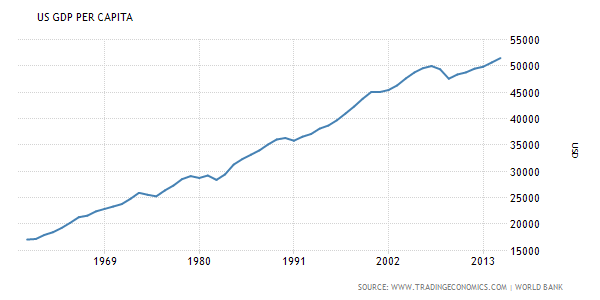
John Maynard Keynes, a prolific British economist of the 19th century, predicted that technological advancements would have an inverse effect on the amount of hours the labor force had to work. According to Keynes, we were set on this trajectory — as technology improves and productivity increases, people will begin to work less. The average workweek in 1930 was 47 hours, and by 1970 that number had gone down to about 39 hours. Yet why have we seen work hours increase after 1970, hovering at about 40 hours per week for the next fifty years? After all, the fifty years before 1970 — a period when colored TV and the microwave were the hot new inventions — average work hours declined by eight hours.
Something doesn’t add up.

GDP per capita in the US between 1947 and 2016 has risen steadily, and in aggregate, the robustness of the economy has grown right on target with Keynes’s prediction. However, the median income has not risen in proportion.
In fact, median income fell 5%¹ between 1973 and 2013 from an average hourly wage of $21.23 to $20.13. Yet the overall economy is booming, inflating the price of goods and services, bidding up cost of living. In other words, to maintain the same standard of living as the generation before us, we must work more, not less, despite leaps and bounds in technological innovation of the past two decades.
A sharp rise in income inequality as a result of highly disproportional redistribution of wealth after 1970 is undeniably the primary cause of this precarious phenomenon. It’s why the reality of today is inconsistent with Keynes’s dream for his “grandchildren” despite every objective data saying it should be otherwise. Keynes’s vision, in his 1930 paper titled Economic Possibilities for our Grandchildren, he predicted that by now, we should be working at around 15 hours a week and still maintaining the same level of productivity and GDP.
This dream has been thwarted due to the centralization of power — power concentrated at the top of the corporate, governmental, institutional, and organizational pyramids. This system of power that we live in is architected in such a way that allows those at the top to make decisions efficiently and effectively for the majority that reside at the bottom of the pyramid. It is not to confuse “efficiently” or “effectively” with “benevolently” or “selflessly.” In fact, the opposite is true.
The genesis of capitalism came from a break-up with feudalism. It was a deliberate result of agricultural productivity, mercantilism, growing populations, and urbanization. It was a tool to organize petty producers from scattered agricultural communities into a cohesive society of commodity producers and trade markets.
The modus operandi that differed between capitalistic society and feudalistic society is that the former runs on the need to accumulate capital for power while the latter ran on the need to maintain class position. This penchant is alive and kicking today. What other driver makes us want to acquire and hold onto wealth so strongly?
It makes sense why, today, we have the candidates we have for presidency. A pyramid-like structure is supported by hundreds of millions rooted at the base. At the pinnacle, there is only room for 1% of the 1% of the population. This dubiously attracts the most sociopathic of forerunners who are in it to obtain and maintain power for power’s sake.
Andreas Antonopoulous illustrates in his Decentralization and the Architecture of Power talk that the wider the base of the pyramid, the farther away the apex. It is to say that the wider the gulf of inequality becomes, the less the ones at the top can relate to the ones at the bottom. One attracted to wield such a high dose of power at the very top is so far removed from those occupying the lower rungs of the societal pyramid that the decisions one makes can only be made for one’s own benefit, not the greater good.
And it benefits those ones to pay you less while you produce more.
“In capitalism, surplus wealth is extracted through economic means; it is because of the market-dependency of the wage-labourer that labour-power is sold.” — Darren Poynton
It’s no wonder that the singular goal of almost every comic book supervillain is to obtain some talisman containing the power of the universe. A seat as the head of state for military brawn or a mogul of media for mass mind control are not far from the veritable magic talisman in this world.
So what’s the opposite of centralized systems of power?
Decentralized systems. It’s spherical rather than pyramid-shaped. If you would imagine the web of the Internet, expanding and contracting as entities enter and exit, decentralized systems, like the web, are a public good owned and accessible by all. There are no barriers to entry. Access is free, not privatized. Content is owned by creators, not the intermediaries. It is, by design, equal and non-hierarchical.
As Millennials mature into the Internet age and build business solutions and organizations at the helm of Decentralization, it is my wish that we not lose sight of what we were destined for. John Maynard Keynes dreamt it. You can enjoy it — less hours, more leisure time. But to make decentralization the de facto system underpinning all future organizations, we must heed Andreas Antonopoulos’s warning that in order to rise above the policies of today, we must not fall into the same traps as our forebears.
“…absolute power corrupts absolutely.” — Machiavelli
Our primary directive was never to work more for the sake of working or accumulating wealth to wield power and status. Our primary directive is to get the most fulfillment out of life by reaching our full potential in what we are passionately, creatively drawn to do in our heart of hearts.
References
¹Friedman, B.M. J Evol Econ (2015). doi:10.1007/s00191-015-0426-4 (http://link.springer.com/article/10.1007/s00191-015-0426-4)
Andreas Antonopoulos @aantonop, Decentralization and the Architecture of Power (
Darren Poynton, The Agrarian Origin of Capitalism (https://libcom.org/library/agraian-origin-capitalism-darren-poynton-2011)
Recommended
The Internet's Own Boy: The Story of Aaron Swartz (
Neil Gaiman 2012 Commencement Speech 'Make Good Art' (
Todd Brison '3 Phases Every Creative Professional Must Go Through' (http://www.toddbrison.com/3-phases-every-creative-professional-must-go/)
. . .
Original post found via https://medium.com/@chiangnificent/https-medium-com-chiangnificent-the-keynesian-dream-aac4a33d55a3#.fyrrs9dyc
There is this theory that EROI (energy returned on energy invested) is continously decreasing and so it is more and more difficult to generate either real economic growth or "good" inflation.
Interesting theory. Do we know why this is happening? And the whole idea of growth YoY for the sake of growth...is just unhealthy.
Nice article and excellent conclusions in the last two paragraphs. Welcome to Steemit Chjango!
Verified:
Disclaimer: I am just a bot trying to be helpful.
Thanks for the warm welcome @pfunk!
Back then work was productive, now most work is management of others that produce... 20% of the population does 80% of the productive work.
@doesntmatter Ain't that the truth. Back when we were building civilizations out of nothing, people had no illusions about putting in the work to build them. Now that we're at the apex of an empire's wealth, consumption leveraged by debt rather than production's been the norm. Well, I guess the only appropriate response would be--enjoy it while ya can!